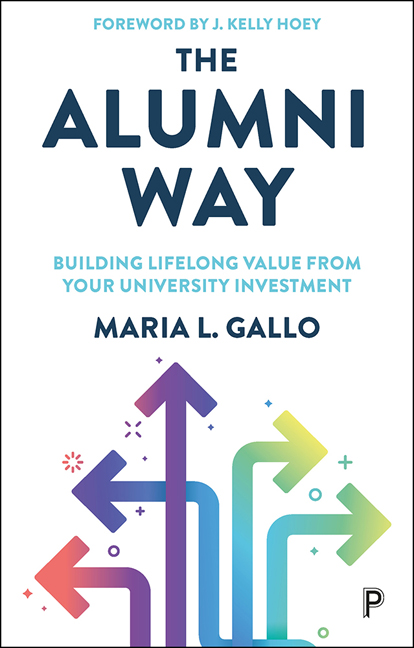Book contents
- Frontmatter
- Dedication
- Contents
- Acknowledgements
- Foreword
- Introduction: We are all alumni
- PART I Charting the course of the Alumni Way
- PART II The Alumni Way trait: Reflection
- PART III The Alumni Way trait: Curiosity
- PART IV The Alumni Way trait: Passion
- PART V The Alumni Way trait: Generosity
- PART VI Alumni: Bringing it into our lives
- Notes
- References
- About the author
- Index
5 - Reflection signpost: Recognize the university is a city
Published online by Cambridge University Press: 13 May 2022
- Frontmatter
- Dedication
- Contents
- Acknowledgements
- Foreword
- Introduction: We are all alumni
- PART I Charting the course of the Alumni Way
- PART II The Alumni Way trait: Reflection
- PART III The Alumni Way trait: Curiosity
- PART IV The Alumni Way trait: Passion
- PART V The Alumni Way trait: Generosity
- PART VI Alumni: Bringing it into our lives
- Notes
- References
- About the author
- Index
Summary
The university is a city within a city. Some small cities are even known as college towns. The population swells during the academic year, offering a boost to the local economy. The cafés, restaurants, shops, banks, theatres, sports facilities, and student accommodation all thrive during the academic year. On campus, there are libraries, parks, sometimes campus police, and hospitals. The campus is home to religious services and spaces, childcare facilities, pubs, community centres, even schools. Virtually all amenities found in a city are available on campus. If not, they have grown on the campus periphery. The university administration, the groundskeepers, the cleaners, and service staff keep the university operating as a smooth, well-oiled machine. There are also committees, volunteers, and even politicians (student politicians at least).
Recognizing the university as a microcosm of society means we can view the institution differently. It isn't just a place of learning, a place to grab a degree and go. These halls of learning form an economy. It is no wonder the university takes on several identities too: employer, carer, healthcare provider, wellness purveyor, educator, restaurateur, consumer, producer, landlord, and tenant. For instance, Simon Fraser University (SFU) was featured in an article for an initiative called UniverCity. Working within a community trust, SFU aims to create sustainable neighbourhoods for better living on Burnaby Mountain. This ‘univer-city’ idea aptly defines all universities; they are not just part of the city – they are the city, as outlined in Figure 5.1.
Consider how the university spills over into the local community. It draws on this diversity to become a place of learning and service. This is a democratization of the universitycommunity relationship, breaking down the traditional university ivory tower. Cities wishing to attract further inward economic investment tend to promote the excellence of their local higher education institutions. This fully maximizes the ‘town and gown’ relationship, supporting cities to become more globally competitive. Meric Gertler, President of the University of Toronto and urban geographer, describes the university as a ‘city-building organization’.
The university also affects the local creative ecosystem. In his book The Rise of the Creative Class, author and urban studies theorist Richard Florida, describes universities as key enablers of creative places.
- Type
- Chapter
- Information
- The Alumni WayBuilding Lifelong Value from your University Investment, pp. 35 - 44Publisher: Bristol University PressPrint publication year: 2021

